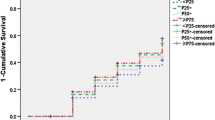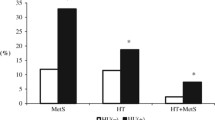Abstract
Whether hyperuricemia is an independent risk factor for hypertension in adults is still under debate. To determine the association between serum uric acid and risk of hypertension in the Chinese population, we conducted a prospective study using the “Kailuan Corporation cohort.” A total of 39,233 adult subjects with available data on serum uric acid were enrolled from 2006 to 2007. Subjects with established hypertension were excluded and were then grouped based on the gender and baseline quartile serum uric acid into F1–4 for women and M1–4 for men with F1 and M1 being the lowest quartiles. Incidence of newly described primary hypertension was reevaluated in 2010–2011. The median (interquantile range) baseline uric acid (UA) was 290 (243–344) μmol/L in men and 230 (194–274) μmol/L in women. During a 4-year follow-up period, 12,844 subjects (31.31 %) were newly diagnosed with hypertension. The incidence of hypertension was 14.36, 16.57, 19.06, and 22.35 % in F1 to F4 and 33.64, 33.97, 36.54, and 40.74 % in M1 to M4, respectively. Multiple logistic regression analysis showed that the odds ratios (ORs) of incident hypertension were 1.17 [95 % confidence interval (CI) 1.00–1.37, P = 0.055], 1.24 (95 % CI 1.06–1.45, P = 0.009), and 1.20 (95 % CI 1.02–1.41, P = 0.027) in F2 to F4 compared to the F1 and 0.98 (95 % CI 0.91–1.05, P = 0.534), 1.05 (95 % CI 0.98–1.13, P = 0.190), and 1.13 (95 % CI 1.05–1.22, P = 0.002) in M2 to M4 compared to the M1. Elevated level of serum uric acid is associated with an increased risk of hypertension in adults.

Similar content being viewed by others
Abbreviations
- BMI:
-
Body mass index
- BP:
-
Blood pressure
- CRP:
-
C-reactive protein
- DBP:
-
Diastolic blood pressure
- eGRF:
-
Estimated glomerular filtration rate
- FBG:
-
Fasting blood glucose
- HDL:
-
High-density lipoprotein
- MI:
-
Myocardial infarction
- LDL:
-
Low-density lipoprotein
- SBP:
-
Systolic blood pressure
- SUA:
-
Serum uric acid
- TC:
-
Total cholesterol
- TG:
-
Triglyceride
References
Liu LS, Writing Group of 2010 Chinese Guidelines for the Management of Hypertension (2010) 2010 Chinese guidelines for the management of hypertension. Zhonghua Xin Xue Guan Bing Za Zhi 39:579–616
Feig DI (2014) Serum uric acid and the risk of hypertension and chronic kidney disease. Curr Opin Rheumatol 26:176–185
Mellen PB, Bleyer AJ, Erlinger TP, Evans GW, Nieto FJ, Wagenknecht LE et al (2006) Serum uric acid predicts incident hypertension in a biethnic cohort: the atherosclerosis risk in communities study. Hypertension 48:1037–1042
Syamala S, Li J, Shankar A (2007) Association between serum uric acid and prehypertension among US adults. J Hypertens 25:1583–1589
Yoo TW, Sung KC, Shin HS, Kim BJ, Kim BS, Kang JH et al (2005) Relationship between serum uric acid concentration and insulin resistance and metabolic syndrome. Circ J 69:928–933
Kansui Y, Ohtsubo T, Goto K, Sakata S, Ichishima K, Fukuhara M et al (2011) Association of serum uric acid with blood pressure in Japanese men. Cross-sectional study in work-site quartile. Circ J 75:2827–2832
Taniguchi Y, Hayashi T, Tsumura K, Endo G, Fujii S, Okada K (2001) Serum uric acid and the risk for hypertension and type 2 diabetes in Japanese men: the Osaka Health Survey. J Hypertens 19:1209–1215
Sundstrom J, Sullivan L, D’Agostino RB, Levy D, Kannel WB, Vasan RS (2005) Relations of serum uric acid to longitudinal blood pressure tracking and hypertension incidence. Hypertension 45:28–33
Perlstein TS, Gumieniak O, Williams GH, Sparrow D, Vokonas PS, Gaziano M et al (2006) Uric acid and the development of hypertension: the normative aging study. Hypertension 48:1031–1036
Xiong Z, Zhu C, Qian X, Zhu J, Wu Z, Chen L (2013) Serum uric acid is associated with dietary and lifestyle factors in elderly women in suburban Guangzhou in Guangdong province of South China. J Nutr Health Aging 17:30–34
Villegas R, Xiang YB, Cai Q, Fazio S, Linton M, Li H et al (2010) Prevalence and determinants of hyperuricemia in middle-aged, urban Chinese men. Metab Syndr Relat Disord 8:263–270
Mazzali M, Hughes J, Kim YG, Jefferson JA, Kang DH, Gordon KL et al (2001) Elevated uric acid increases blood pressure in the rat by a novel crystal-independent mechanism. Hypertension 38:1101–1106
Feig D, Soletsky B, Johnson R (2008) Effect of allopurinol on blood pressure of adolescents with newly diagnosed essential hypertension. JAMA 300:924–932
Wu S, Li Y, Jin C, Yang P, Li D, Li H, Shen C (2012) Intra-individual variability of high-sensitivity C-reactive protein in Chinese general population. Int J Cardiol 157:75–79
Johnson RJ, Kang DH, Feig D, Kivlighn S, Kanellis J, Watanabe S et al (2003) Is there a pathogenetic role for uric acid in hypertension and cardiovascular and renal disease? Hypertension 41:1183–1190
Grayson PC, Kim SY, LaValley M, Choi HK (2011) Hyperuricemia and incident hypertension: a systematic review and meta-analysis. Arthritis Care Res (Hoboken) 63:102–110
Wu Y, Huxley R, Li L, Anna V, Xie G, Yao C, Woodward M, Li X, Chalmers J, Gao R, Kong L, Yang X, For the China NNHS Steering Committee (2008) Prevalence, awareness, treatment, and control of hypertension in China: data from the China National Nutrition and Health Survey 2002. Circulation 118:2679–2686
Wang J, Zhang L, Wang F, Liu L, Wang H, China National Survey of Chronic Kidney Disease Working Group (2014) Prevalence, awareness, treatment, and control of hypertension in China: results from a national survey. Am J Hypertens 27:1355–1361
Kang DH, Park SK, Lee IK, Johnson RJ (2005) Uric acid-induced C-reactive protein expression: implication on cell proliferation and nitric oxide production of human vascular cells. J Am Soc Nephrol 16:3553–3562
Perlstein TS, Gumieniak O, Hopkins PN, Murphey LJ, Brown NJ, Williams GH et al (2004) Uric acid and the state of the intrarenal renin-angiotensin system in humans. Kidney Int 66:1465–1470
Cappuccio FP, Strazzullo P, Farinaro E, Trevisan M (1993) Uric acid metabolism and tubular sodium handling. Results from a population-based study. JAMA 270:354–359
Bombelli M, Ronchi I, Volpe M, Facchetti R, Carugo S, Dell’oro R et al (2014) Prognostic value of serum uric acid: new-onset in and out-of-office hypertension and long-term mortality. J Hypertens 32:1237–1244
Kim SY, Guevara JP, Kim KM, Choi HK, Heitjan DF, Albert DA (2009) Hyperuricemia and risk of stroke: a systematic review and meta-analysis. Arthritis Rheum 61:885–892
Liu Y, Jin C, Xing A, Liu X, Chen S, Li D et al (2013) Serum uric acid levels and the risk of impaired fasting glucose: a prospective study in adults of North China. PLoS One 8:e84712
Pogodina AV, Dolgikh VV, Rychkova LV (2014) Uric acid and factors of cardiometabolic risk in adolescents with arterial hypertension. Kardiologiia 54:36–42
Heo SH, Lee SH (2010) High levels of serum uric acid are associated with silent brain infarction. J Neurol Sci 297:6–10
Viazzi F, Leoncini G, Ratto E, Falqui V, Parodi A, Conti N et al (2007) Mild hyperuricemia and subclinical renal damage in untreated primary hypertension. Am J Hypertens 20:1276–1282
Cipolli JA, Ferreira-Sae MC, Martins RP, Pio-Magalhães JA, Bellinazzi VR, Matos-Souza JR, Junior WN (2012) Relationship between serum uric acid and internal carotid resistive index in hypertensive women: a cross-sectional study. BMC Cardiovasc Disord 12:52
Gómez-Marcos MA, Recio-Rodríguez JI, Patino-Alonso MC, Agudo-Conde C, Rodríguez-Sánchez E, Gómez-Sánchez L et al (2013) Relationship between uric acid and vascular structure and function in hypertensive patients and sex-related differences. Am J Hypertens 26:599–607
Fang JI, Wu JS, Yang YC, Wang RH, Lu FH, Chang CJ (2014) High uric acid level associated with increased arterial stiffness in apparently healthy women. Atherosclerosis 236:389–393
Samimi A, Ramesh S, Turin TC, MacRae JM, Sarna MA, Reimer RA et al (2014) Serum uric acid level, blood pressure, and vascular angiotensin II responsiveness in healthy men and women. Physiol Rep 2(12):e12235
Acknowledgements
We are very grateful to all participants for their cooperation and for giving consent to participate in this study. We thank all the staff for their dedication.
Author information
Authors and Affiliations
Corresponding author
Ethics declarations
Disclosures
None.
Funding
This study was supported by the National High Technology Research and Development Program of China (973 Program, No. 2012CB517700) and National Natural Science Foundation of China (No. 31170840 and No. 81471536).
Additional information
Liu-fu Cui and Hui-jing Shi contributed equally to this study.
Rights and permissions
About this article
Cite this article
Cui, Lf., Shi, Hj., Wu, Sl. et al. Association of serum uric acid and risk of hypertension in adults: a prospective study of Kailuan Corporation cohort. Clin Rheumatol 36, 1103–1110 (2017). https://doi.org/10.1007/s10067-017-3548-2
Received:
Revised:
Accepted:
Published:
Issue Date:
DOI: https://doi.org/10.1007/s10067-017-3548-2




